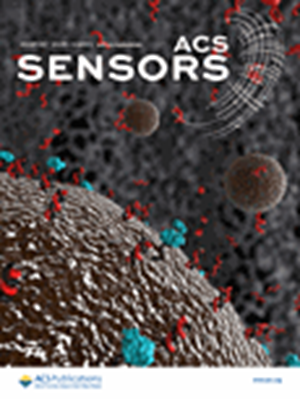基于cu20 - cufe2o4纳米阵列的低温增强超灵敏出气H2S传感器。
IF 9.1
1区 化学
Q1 CHEMISTRY, ANALYTICAL
引用次数: 0
摘要
本研究采用二维电沉积原位组装方法,在硅衬底上成功制备了基于p-n型Cu2O-CuFe2O4异质结构有序纳米线阵列的高性能H2S传感器。与Cu2O相比,Cu2O- cufe2o4纳米线阵列具有理想的界面势垒结构和更高的初始电阻,在室温(20±3℃)下对10 ppm H2S的响应提高了225倍,响应时间缩短了2400 s以上。该传感器具有出色的灵敏度(LOD = 10 ppb;响应= 234.5),选择性和湿度抗性(在60-90% RH下稳定响应~ 6000至10 ppm的H2S)。值得注意的是,它显示出独特的低温增强传感,在-10°C时,对10ppm H2S的响应为8.365 × 104(20°C时为1.144 × 104)。该传感器成功应用于人体口腔呼出气体中H2S的检测,显示了其在无创疾病诊断中的潜力,为开发室温呼吸分析传感器提供了一种有前景的方法。本文章由计算机程序翻译,如有差异,请以英文原文为准。
Low-Temperature-Enhanced and Ultrasensitive Exhaled H2S Gas Sensor Based on Cu2O-CuFe2O4 Nanoarrays.
In this study, employing a 2D electrodeposition in situ assembly method, a high-performance H2S sensor based on a p-n type Cu2O-CuFe2O4 heterostructure ordered nanowire arrays was successfully fabricated on silicon substrates. Compared to Cu2O, Cu2O-CuFe2O4 nanowire arrays exhibits an ideal interfacial barrier structure and higher initial resistance, with a response to 10 ppm of H2S at room temperature (20 ± 3 °C) increased by 225 times and a response time reduced by over 2400 s. The sensor demonstrates exceptional sensitivity (LOD = 10 ppb; response = 234.5), selectivity, and humidity resistance (stable response ∼6000 to 10 ppm of H2S at 60-90% RH). Notably, it shows unique low-temperature-enhanced sensing, with a response of 8.365 × 104 to 10 ppm of H2S at -10 °C (vs 1.144 × 104 at 20 °C). The sensor was successfully applied to detect H2S in human oral exhaled breath, demonstrating its potential for noninvasive disease diagnosis and offering a promising approach for developing room-temperature breath analysis sensors.
求助全文
通过发布文献求助,成功后即可免费获取论文全文。
去求助
来源期刊

ACS Sensors
Chemical Engineering-Bioengineering
CiteScore
14.50
自引率
3.40%
发文量
372
期刊介绍:
ACS Sensors is a peer-reviewed research journal that focuses on the dissemination of new and original knowledge in the field of sensor science, particularly those that selectively sense chemical or biological species or processes. The journal covers a broad range of topics, including but not limited to biosensors, chemical sensors, gas sensors, intracellular sensors, single molecule sensors, cell chips, and microfluidic devices. It aims to publish articles that address conceptual advances in sensing technology applicable to various types of analytes or application papers that report on the use of existing sensing concepts in new ways or for new analytes.
 求助内容:
求助内容: 应助结果提醒方式:
应助结果提醒方式:


